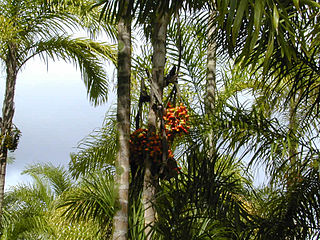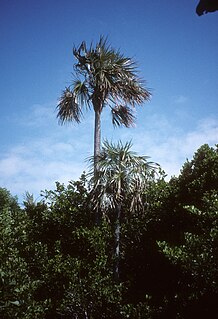
Calamus is a genus of flowering plants in the palm family Arecaceae that are among several genera known as rattan palms. There are an estimated 400 species in this genus, all native to tropical and subtropical Asia, Africa, and Australia. They are mostly leaf-climbing lianas with slender, reedy stems. To aid scrambling some species have evolved hooks on the underside of the midrib, or more commonly by modified "pinnae" or tendrils in the form of stout, backward-pointing spines. These stems may grow to lengths of 200 metres.

Bactris is a genus of spiny palms which is native to the Mexico, South and Central America and the Caribbean. Most species are small trees about 2 m tall, but some are large trees while others are shrubs with subterranean stems. They have simple or pinnately compound leaves and yellow, orange, red or purple-black fruit. The genus is most closely related to several other spiny palms—Acrocomia, Aiphanes, Astrocaryum and Desmoncus. The fruit of several species is edible, most notably B. gasipaes, while others are used medicinally or for construction.

Copernicia is a genus of palms native to South America and the Greater Antilles. Of the known species and nothospecies (hybrids), 22 of the 27 are endemic to Cuba. They are fan palms, with the leaves with a bare petiole terminating in a rounded fan of numerous leaflets. The species are small to medium-sized trees growing to 5–30 m tall, typically occurring close to streams and rivers in savanna habitats.

Coccothrinax is a genus of palms in the family Arecaceae. There are more than 50 species described in the genus, plus many synonyms and subspecies. A new species was described as recently as 2017. Many Coccothrinax produce thatch. In Spanish-speaking countries, guano is a common name applied to Coccothrinax palms. The species are native throughout the Caribbean, the Bahamas, extreme southern Florida and southeastern Mexico, but most of the species are known only from Cuba.

Desmoncus is a genus of mostly climbing, spiny palms native to the Neotropics. The genus extends from Mexico in the north to Brazil and Bolivia in the south, with two species present in the southeastern Caribbean.

Carpoxylon macrospermum is a species of palm tree endemic to Vanuatu, and the only species in the genus Carpoxylon.

Ceroxylon is a genus of flowering plant in the family Arecaceae, native to the Andes in Venezuela, Colombia, Ecuador, Peru, and Bolivia, known as Andean wax palms.

Chambeyronia is a genus of flowering plant in the family Arecaceae. It contains the following species, both endemic to New Caledonia: Relationships between Chambeyronia and the other genera of subtribe Archontophoenicinae, including the Australian Archontophoenix and the New Caledonia endemic Actinokentia and Kentiopsis are unresolved.

Cyphophoenix is a genus of flowering plant in the family Arecaceae. It contains 4 known species, all endemic to New Caledonia:. The relationships between Cyphophoenix and some other genera of the tribe Basseliniinae including Physokentia and the New Caledonia endemic Burretiokentia are not clear.

Cyrtostachys is a genus of flowering plant in the family Arecaceae. Its species are found in southeast Asia, New Guinea, and in some of the South-Central and Southwest Pacific island habitats of the Oceanian realm.
Physokentia is a genus of flowering plant in the palm family, native to certain islands of the western Pacific.

Ptychosperma is a genus of flowering plant in the family Arecaceae. Most are native to Australia and/or New Guinea, with a few in the Solomon Islands and in Maluku Province of eastern Indonesia. Some have been cultivated abroad as house or garden plants, and reportedly naturalized in certain regions.

Kerriodoxa elegans, the white backed palm, is the only species of palm tree in the genus Kerriodoxa, in the family Arecaceae.
John Dransfield is an honorary research fellow and former head of palm research at the Royal Botanic Gardens, Kew, United Kingdom, as well as being an authority on the phylogenetic classification of palms.
Areca gurita is an extant species of single-stemmed palm tree indigenous to the Malaysian state of Sarawak on Borneo. Following Heatubun's identification of A. gurita in 2011, he recorded specimens in the vicinity of Kota Padawan, Kampong Patak, and Kampung Siburan, south of Kuching.
Clinosperma is a palm tree genus in the family Arecaceae.

Saribus woodfordii is a species of fan palm which is native to an area from southeastern Papua New Guinea to the Solomon Islands.
Manjekia is a monotypic genus of palm for a species of palm native to Biak island, Indonesia, off the northwest coast of New Guinea. The genus was proposed in 2014.
Saribus chocolatinus is a species of palm tree in the genus Saribus, which is native to Papua New Guinea. It is a fan palm.
Wallaceodoxa is a genus of palm, in the subtribe Ptychospermatinae. It has only one currently accepted species, Wallaceodoxa raja-ampat, native to the Raja Ampat Islands off the Bird's Head Peninsula of New Guinea. It grows on limestone soils.












